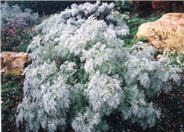
Common name:Silver Mound Artemisia
Botanical name:Artemisia schmidtiana 'Silver Mound'
This mounding perennial will grow 1'-3' high and has medium-sized silvery white leaves with yellow and white flowers.
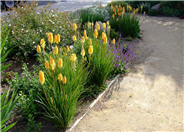
Common name:Torch Lily
Botanical name:Kniphofia hybrids
This perennial will grow to about 6' tall and has large green leaves with red, orange, and yellow flowers that bloom in spring, summer, and fall.
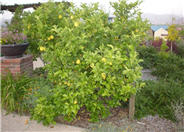
Common name:Sweet Orange cultivars
Botanical name:Citrus sinensis
This tree will grow 20'-30' high and 10'-15' wide; it produces sweet, tasty oranges. It has shiny green, leathery foliage and produces clusters of fragrant white flowers that bloom in the spring.
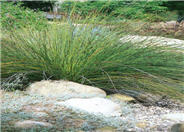
Common name:Small Cape Rush
Botanical name:Chondropetalum tectorum
Chondropetalum tectorum has 3'-4' tall stems that shoot out in all directions from the roots. Each stem has papery bracts connected to the ends that turn from tan to dark drown, then fall off. Chondropetalum can grow in marshes, in the ground with regular watering, or in drought conditions.
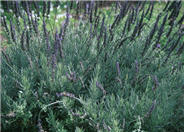
Common name:Goodwin Creek Gray Lavender
Botanical name:Lavandula 'Goodwin Creek Gray'
Lavandula 'Goodwin Creek Gray' is an evergreen shrub. This dense foliaged plant grows to 2.5'-3' high and 3'-4' wide, with silvery leaves that are toothed at the tips. Deep violet-blue flowers bloom from spring to late fall.
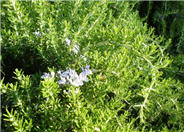
Common name:Rosemary
Botanical name:Rosmarinus officinalis
Rosemary is hardy in full sun areas where winter temperatures do not drop below 10 degrees F. They can be grown in a clay pot with well-drained, porous soil in bright indoor light, and will also flourish on the backporch in spring, summer and fall. Its beautiful, slowly trailing stems and shiny slender leaves are perfect for showing off the small, light blue flowers that blossom in the summer.
Permeable Surfaces
If you have impermeable paving that you would like to make permeable, there are two main methods for doing so:
1. Break up hard paved surfaces to create spaces for water to seep through.
2. Remove and replace the surfaces with permeable paving.
Click in the green box for more information
| Designer: Stratton, Semmes, Madrone | Large Flagstone Pavers |
Photographer: GardenSoft |
Soils and Compost:
Physical weed control, including mulching, or hand removal protects the watershed from harmful chemicals.
Integrated Pest Management:
Develop healthy soil for plants that are vigorous and naturally pest-resistant.
